#what an outdated 2011 concept
Explore tagged Tumblr posts
Text
An Explanation of DC's Multiple Universal Reboots and How to Navigate DCU Canon
This is an expansion of a shorter explanation I gave on my Batfam Starter Recs reading list. I figured it might be helpful to have it as a standalone explanation for new comic readers learning how to navigate DC's various attempts to deal with the concept of canon.
The Multiverse is a storytelling device within DC Comics that explains how most of the comics DC has published are tied together or are separate from each other. There exists a "main" universe, where most of DC's published comics collectively take place, and then several alternate universes where things happened differently than they did in the main universe. The multiverse allows writers to explore various concepts like "what if the Jack the Ripper murders happened in Victorian-era Gotham?" and "what if DC's women were the primary heroes of their universe and fought in World War II?" without affecting anything going on in the main universe.
DC Comics canon works in three "mainline" universes:
the pre-Crisis universe (everything published from the beginning of DC Comics until the Crisis on Infinite Earths event in 1986)
the post-Crisis universe (everything published between 1986 and 2011)
the post-Flashpoint universe (everything published from 2011-now)
In the 1980s, management at DC decided that continuity had become too outdated, convoluted, and contradictory to tell coherent stories within a shared universe as more stories were told, new characters were introduced, and new context to prior stories was added. The company had previously attempted to solve this problem in the 1960s by publishing "Flash of Two Worlds," assigning existing stories to two different universes (Earth-One and Earth-Two), and creating a smattering of other alternate universes (Earth-Three was the home of the Crime Syndicate, evil AU versions of the Justice League, for example), but found that this did not actually solve the issue.
So. They decided to do a total universal reboot. That reboot was initiated by the company-wide crossover event known as Crisis on Infinite Earths, published from 1985 to 1986.
COIE effectively rebooted the entire internal DC Universe from the dawn of time onward. A new universal history now existed: the vast majority of characters/character history, history, and events from the varying alternate timelines that existed in the previous universe were retold, retooled, condensed, and/or thrown out in favor of a new, theoretically streamlined single reality. From 1986-2011, DC Comics mainline continuity was published in this shared universe, which industry professionals and fans alike called the 'post-Crisis' universe; in-universe, we refer to this primary version of DC's continuity "New Earth" (or occasionally, Earth-0).
For a wide variety of reasons that I won't get into here, DC completely rebooted their universe again in 2011 following the Flashpoint event comic. This new primary universe—interchangeably called the New 52 universe, post-Flashpoint universe, or Prime Earth, depending on the conversation—once again drastically changed many characters’ histories, personalities, and relationships with each other (sometimes for the better, most of the time for the worse). This is the current universe for DC's main comic line.
Within these three overarching iterations of the DCU, there were several events aimed to clean up, refresh, or reorganize various continuity problems. You may hear people refer to "post-Zero Hour" continuity, for example, to describe post-Crisis events/character histories that were revamped after Zero Hour: Crisis in Time! was published in 1994. "post-Rebirth" continuity, another common descriptor, refers to the reorganization of the post-Flashpoint/Prime Earth universe that happened after the Rebirth event in 2016.
GENERALLY SPEAKING, these are the most common ones you'll hear about:
Pre-Crisis Universe (1937-1986): "Flash of Two Worlds" (1961)
Post-Crisis Universe (1986-2011): pre/post-Zero Hour (1994-2005), post-Infinite Crisis and One Year Later (2005-2008), & post-Final Crisis (2008-2011)
Post-Flashpoint Universe (2011-present): The New 52 (comics written from 2011-2015), Convergence/DCYou (the first attempt to fix New 52 continuity, lasted from 2014-2016), pre/post-Rebirth (2016-2021)—and within Rebirth continuity there were two events, Dark Knights: Metal and its sequel, Death Metal, that did some minor universal revamps (2018-2021)—and post-Death Metal continuity, also known as Infinite Frontier (2021-present). Dark Crisis (2022) also exists but didn't really change the multiversal lore status quo, just simplified the explanation.
Other important universal lore-related things to note about these events:
Prior to Crisis on Infinite Earths, the DCU was an "infinite multiverse." There were no limits on the number of alternate universes that existed and no in-depth explanation for how they were connected or unconnected to the DCU's main timeline.
COIE destroyed the infinite multiverse and condensed everything into one, single universe. Between 1986 and 2005, there were technically no acknowledged alternate universes beyond the "antimatter universe."
"Hypertime" was created by Mark Waid and Alex Ross in 1999 as a way to get around this rule and eventually became the "go-to" way of explaining and fixing various continuity errors. Hypertime is a network of alternate timeline "echoes" that branch off from the main DCU timeline and occasionally overlap with each other, causing alterations in reality.
Since there could only be one timeline, continuity discrepencies were often "fixed" by explaining that one version of events happened in a previous, now destroyed timeline (that characters may or may not remember). Characters could cross from one timeline to another if needed, but any changes resulting from time travelers messing with events caused the destruction of their orginal timeline.
The "Elseworlds" imprint was another method of writing alternate universe stories without explicitly acknowledging the multiverse existed. DC officially just called these books "non-canon" stories without trying to explain how they existed in relation to the main universe. Most if not all of these stories are now considered part of the multiverse.
The infinite multiverse was briefly restored after Infinite Crisis in 2005 and then merged into a single 52-universe multiverse the year afterwards in 52. This new, limited multiverse was explained as there being an "original" Earth (Earth-0) with each successive universe being further and further removed from that one.
The initial post-Flashpoint/New 52 explanation of the multiverse was that there was a limited 52-universe multiverse. That explanation was somewhat overwritten after Rebirth and fully retconned after Death Metal.
Death Metal introduced the concept of the "omniverse," a multiverse of infinite multiverses. Yes, this is dumb. Yes, we generally ignore it and it has now been fully retconned.
The "Dark Multiverse" (a temporary "dark negative counterpart" of each Multiverse reality created by the fears of a universe's people) is theoretically a thing that exists. No, no one else really understands it either and the concept is generally restricted to the two Metal events.
Since Dark Crisis, the DCU is once again a single infinite multiverse in the vein of late pre-Crisis continuity. Every universe and continuity exists, and some are closer to the mainline reality than others.
Right now, the main DCU is once again a singular multiverse with an infinite number of universes. Technically, every version of "mainline universe" history throughout the existence of the multiverse is now considered to have occurred and is remembered by the inhabitants of Prime Earth. In practice, this means that "everything is nebulously canon or non-canon until explicitly acknowledged by a writer to have definitively happened and/or be something that a character remembers happening to them."
Unfortunately, not a lot of writers are doing much with that concept right now outside of picking and choosing their favorite parts of mainline canon to focus on and/or re-canonize, but it at least presents a path forward where a lot of the continuity and characterization issues created by the New 52 reboot are able to be properly addressed.
I hope this explanation was helpful for people, and I'm happy to try and field any further questions as well!
#long post#dc comics#dc meta#dc multiverse#lol that explanation of hypertime is sooooooo condensed but it's basically impossible to properly explain without its own dedicated post
350 notes
·
View notes
Text
Skylanders: Giants (review)
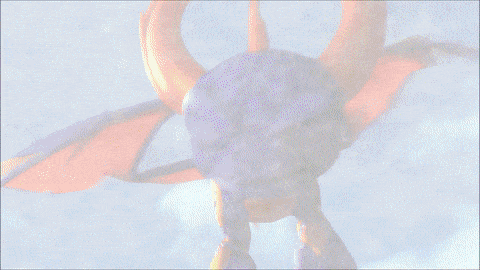
So, I meant to make a review talking about this game a bit ago, but life got in the way. But now that it's midnight as of writing this, and I ate some comfy food, I can finally get out my thoughts for this game. If you're not in the know of what a Skylander is and of the games, figures, and the whole toys-to-life thing, you're not alone! Back in the early 2010s, parents were learning what a Spyro and a Stealth Elf were, too! Toys-to-life was a concept that skyrocketed into popularity back then. The idea was simple: use your toys to play the game. A few other companies, other than Toys-For-Bob, used this concept after they released Skylanders: Spyro's Adventure on October 12th, 2011. (Just thinking of how ong ago makes my head hurt.) This soon-to-be series of games came to a wide variety of consoles such as the Xbox 360, PS3, and even the Nintendo 3DS. When you bought the game, it came with a box set of 3 figures of some of the characters within the game, a portal, and instructions. Most of the portals could plug into the console, but as for the 3DS edition, it needed a few batteries to power on. Then you could pop one of the figures onto the portal and watch your toy come alive. Each character had their own set of skills and abilities. Some of these can be unlocked throughout the game by a level-up system. I played Spyro's Adventure when it first came out as a gift for either my Christmas or my Birthday. Personally, the game grew on me, and I would also play with the figures as regular toys. But recently, I wanted to play some games that I had fun with as a kid, and it just so happened that a local store had the Skylanders figures in stock along with the second game in the series, Giants.
Now comes the actual review part. I did enjoy my time with Giants, just as I did with the first game. However, I did get a little annoyed with having to switch from one toy to another, even with my little army of Skylanders nearby to make things easier. With that little nitpick out of the way, though, the story was simple. The Giants in this adventure disappeared after a huge battle against the Arkeyan Empire and its King by using an Iron Fist Gauntlet. Lord Kaos comes back to the world of the Skylands, ready to conquer it again, and accidentally turns on the Conquertron. With it, he tries to find the lost Iron Fist to take over Skylands once and for all. Of course, as the protagonist in this story, we, the Portal Master, must use the Giant Skylanders to stop Kaos. I will admit, while the plot seems simple, it's nice to have every so often. Like I said with my Super Lucky's Tale review, not everything needs to be overly complex. Simplicity is also nice, too. Plus, with this game geared towards kids, a simple plot is easier for them to follow along with. But I'm 24, so what do I know?
As I mentioned before, all Skyladers have different abilities and powers they can unlock by leveling them up. It was very helpful to have already used Skylanders at my place with some of the levels. Believe it or not, this game can be very challenging even on normal mode. Sometimes, there would be a massive mob of enemies hacking at you all at once, not giving you a chance to breathe. Though they were frustrating, with the right character, they were easy to get through. Most of the time, that is. Sometimes, there would be larger enemies along with archers trying to strike at you. These archers could be ruthless if not dealt with quickly. Sure, I could have gotten some more power-ups by completing a few challenges, but I was more interested in the story and what was in store.
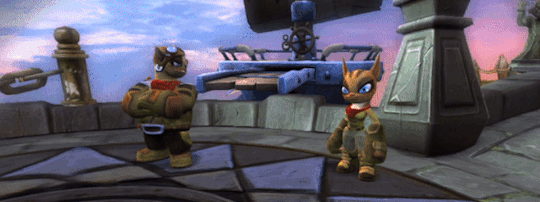
I don't have a lot to say about the characters we meet along the way. Captain Flynn (voiced by Patrick Warburton), along with Kali (voiced by Sumalee Montano), helps us throughout our journey to the Arkeyan Empire, or at least what's left of it. You can tell that this game is outdated with all kinds of cringey "romance" lines from Flynn. Though they never say it, it's implied that he likes Cali and takes her annoyance as a sort of "I think she likes me" card. It's annoying and feels very strange to me. Ignoring Flynn's ego, though, the two are charming in a way. Along the way, we meet other characters such as Hugo, a smart guy who's afraid of the clouds, Brock, a large troll who loves brawling but is a big sweetheart, and a few other characters. I also liked Kaos and his henchman, Glumshanks. One thing that's interesting about the characters in this game is that there is a mini-game called SkyStones, which is like tic-tac-toe but with spikes and enemies with fight throughout the game as the game pieces. Sometimes within a level, if you chat with somebody, they'll ask you to play SkyStones with them. If you win, you could get money or even more pieces to choose from for harder fights. It reminded me of Cult of the Lamb with its different mini-games like fishing and Knucklebones. It adds a nice little break for players, and sometimes, I do need a break from hacking and slashing.
As for the gameplay, I thought overall that it was smooth and easy to control. There were a few bugs that would cause me to die, but nothing too game-breaking. The characters were easily the best part of the game. Their figures are very unique in design, though in-game, I wish they had a few more lines to choose from other than reused dialogue. It would drive me a little insane to hear Eye-Brawler, one of the Giants, say the same eye pun over and over. Over time, though, I got used to it. I feel like you kind of have to with these sorts of games. SpongeBob games are very well-known for reused and repetitive dialogue. Either way, each character I chose was easy to learn. Some characters like Sonic Boom or Whirlwind have launching attacks, which confused me as to why their attacks weren't landing where I wanted them to at first. Luckily, there is a menu that you can go to at any time to look at what button combo does what. Little things like this make the game much easier to understand, especially if you have over 20 characters to choose from.
Overall, I enjoyed my time with this game. Sure, the plot was simple and there were a few annoying things to it, but I do think that it's an interesting game to go back and play again and again. Not to mention that there are so many things to collect, like hats and scrolls. There is a ton of replayability to be had, and it made me happy that the game wasn't a chore to go through. I would rank it an 8/10. These types of games are nice to just relax with and play with a friend. While I know there may never be another Skylanders game due to its history of overworking game devs, I hope that one day, there will be a resurgence of toy-to-life games again. Although with the rate that the gaming industry is going with prices are up to my neck, it's hard to say for certain. Either way, I look forward to playing the other Skylander games in this series. I have a fascination with it for one reason or another.
#spilled thoughts#video games#game review#gaming#nintendo#retro gaming#skylanders#spyro the dragon#skylanders spyro's adventure#toys to life#xbox#review
1 note
·
View note
Text
7. Representation - Analysing the male gaze and its influence on the gaming industry.
Representation, in the world of video games, is how the video games portray culture, race, people, ethnicity and more, and how they get to be seen and heard in the video games. These ways of representation can be good, bad, different, or even incorrect, but that depends on who you ask as its up to the viewer to make their own decisions based on what they see. This can cause issues however as people can often believe that seeing is believing, and that it is the most important factor for understanding the world for what it really is. Berger (1972). People can make come to their own conclusions based on the visual representations presented to them through video games, cultural and racial references can be portrayed in video games that may not be entirely accurate but because the viewer saw it in a video game, may assume the wrong idea of how it’s been represented.
Jenks (1995) explores the nature in which humans use the term “to see” in the same context as the word “to know”. In this context, a phrase such as “do you see what I mean?” is actually asking the question, “do you know what I mean?”. Though it is arguably arbitrary as there is no linguistic reason for this to make sense, Jenks highlights how vision and knowledge can be interpreted the same, as to see is to understand, and to understand is to know. With this concept in mind, can further enhance the possibility that what people see, that is represented in a video game, means that they think they may then know or understand, which can cause misconceptions.
The Male Gaze, coined by Laura Mulvey, is the idea about how women are objectified in media such as films, shows and games, in a more male dominated industry, they are the ones who make more of the decisions and directions, therefore they cater towards their own interests more than anyone else’s or other women’s (King, 2020). An example of this would be a character’s design choices and appearance, taking for example the characters from the Mortal Kombat games.

The female characters design choices are designed in a way to appeal to the heterosexual male audience, all the characters all possess thin waists, large breasts and long legs, all while wearing minimal more revealing outfits and showing a lot of, its interesting to point out as well that, despite the gameplay being a fighting game, most of them are wearing high heels, so from a gameplay design point of view, no one would want to fight in high heels, but it fits the narrative to appeal to the male gaze more with high heels, so this has clearly had an influence in design. (Fowlie, 2011)
In comparison to the female characters, the male characters host a wider variety of outfits, wearing more suitable and diverse clothing, some characters do show a lot of skin similar to how the female characters look, though show more signs of showing strength in the design choice rather than anything else. It isn’t just about what the characters wear, but how the camera looks at the characters too, the males stand with battle stances, ready for war and showing courage, whereas the females pose look more sexualised, showing off their curves and bodies for the attention of the male gaze.

It isn’t just in character design where the male gaze has influenced gaming, narrative tropes and the constant exposure of misrepresentation also has an influence. The classic “Damsel in Distress” such a Super Mario, where it is up to the male protagonist to be the hero and save the pretty female princess from danger has been around for decades, can lead to players assuming that other games or instances where there is a male and female character, this would be idea, based on Jenks (1995).
In conclusion, the way the male gaze has an influence on the gaming industry stems from the games outdated concept that games are mainly played by men, and mainly are for men, which leads to designer ideas catered to that demographic, in the hopes to ultimately generate more revenue and sales. However in modern times things are slowing changing, more females are entering the gaming industry and can provide better insight and perspective and the concept of the male gaze is being more brought forward to light, with people making a stand and voicing their opinions on the misrepresentation not just with women, but with race, culture and sexuality, and calling for a better use for representation in video games.
Bibliography
Berger, J., 1972. Ways of Seeing. [Online] Available at: https://www.penguin.co.uk/books/56465/ways-of-seeing-by-berger-john/9780141035796 [Accessed December 2024].
Jenks, C., 1995. Visual Culture. [Online] Available at: https://www.taylorfrancis.com/books/edit/10.4324/9781315084244/visual-culture-chris-jenks?refId=48bf5e73-7749-472d-a549-7b4f779ac78e&context=ubx [Accessed December 2024].
King, C. S., 2020. The Male Gaze in Visual Culture. [Online] Available at: https://www.taylorfrancis.com/chapters/edit/10.4324/9780429448317-10/male-gaze-visual-culture-claire-sisco-king [Accessed December 2024].
Fowlie, C., 2011. Building Character, an Exploration of Character Design. [Online]
Available at: https://callumhonoursproject.wordpress.com/2015/12/11/case-study-mortal-kombat-2011/
[Accessed December 2024].
https://media-studies.com/male-gaze/ [Accessed December 2024].
0 notes
Text
the older bobs burgers gets the more unrealistic it is that tina wouldn't have a cellphone at her age and i love that the show keeps acknowledging that while also refusing to actually give her a cellphone. everyone i knew when i was in middle school had a cellphone or some kind of device and this was in like 2014 she is DYING out here loren bouchard
#i feel like they could give her a cellphone in an episode and have it be a storyline#but also it stays throughout the rest of the show so she can text friends or whatever#but i dont really care either way its kinda charming. love the emergency phone#what an outdated 2011 concept#txt#bob's burgers
27 notes
·
View notes
Text
July 15, 2022
Shaun of the Dead (2004)
The uneventful, aimless lives of a London electronics salesman and his layabout roommate are disrupted by the zombie apocalypse.

JayBell: I have to admit, I had high expectations for this cult classic, especially because I like a good zombie movie (with specific exception to Warm Bodies which remains one of the worst movies I’ve ever seen).
First, I thought it would be funnier. Sure, there was a few chuckles, but it wasn’t as funny as I was expecting. Even the best friend character, whose major purpose is to be funny, just wasn’t. This is mainly what hurts my experience with the movie the most. The movie seems to promise a lot of comedy, but doesn’t follow through on it for me. By the end of the movie, I honestly felt like it got a little slow in pacing.
The concept for the movie is great. It’s a guy who’s kind of complacent in his life and in his relationship, which leads to his girlfriend breaking up with him. He also has a strained relationship with his stepfather, which has a nice resolution in the movie. So it seems that a zombie apocalypse is the perfect time to make an effort and become the confrontational, take charge person he wants to be.
Unfortunately, concept was greater than its execution. It wasn’t a painful experience, but I can’t deny my disappointment.
Rating: 5/10 cats 🐈
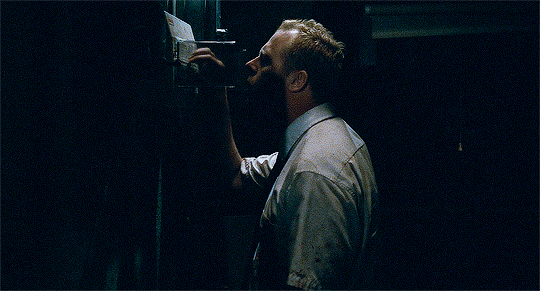
Anzie: What to say??? I think I had more expectations I guess?? I at least expected this movie to be fun. And it’s not that it’s outdated or filled with cringy nostalgia of the early 2000s- it’s just kinda boring?? It started out promising and the end bar scene was kinda cool. The fact that my brother had this on dvd and said he really liked it is quite concerning. I feel like the characters were a tad annoying for some bits (and the wittiness was lost on me most of the time). It all just feels like it didn’t mesh right and was slow?? And I really hate to admit this, but I really did wholeheartedly love Paul (2011), soooo I dunno- (Actually I do it’s probs that Seth Rogan was a deviant alien).
Also when I found out it was an Edgar Wright movie that made me sad because I really love Baby Driver (2017) and Scott Pilgrim v The World (2010). - I do have to give props that the filming and shots at times felt really cool. I know in terms of what makes a movie that isn’t a lot- but it is what it is - and the story of Shaun of the Dead isn’t it. I know it’s a parody of zombie movies and has a cult following, but I wasn’t feeling the love. I might not just be into zombies movies?? - except Scooby Doo on Zombie Island (1998) of course and maybe that’s why I can never accept another as truly the best zombie movie.
Final thought: does it warrant my full wrath of hate, no. But is it the best zombie movie of all time? Also no.
Rating: 4/10 zombies 🧟♀️
2 notes
·
View notes
Text
Tagged by: the lovely and talented @cherrydreamer
Tell me which 5 TV shows make you feel better, then tag 10 other blogs.
Im dyslexic and I got the numbers mixed up so it’s 10 shows now whoops
(Through this I’ve realized how much I absolutely guzzle American content. I need recs from other countries so plz HIT A GIRL UP)! This is going to be long as fuck because I’m so passionate about storytelling. Hope you can find something comforting to watch <3
1. How I Met Your Mother: I love everything about this show. From the overarching plotline of “something better is always coming,” and “Nothing in life is legendary unless your friends are there to see it,” to the technical design (The mother is a Yellow Umbrella, Robin is the Blue French Horn) to the intricacy of how this story is told, How I Met Your Mother is integral to my happiness. So much so that whenever I have a panic attack my partner turns on HIMYM. I love it.
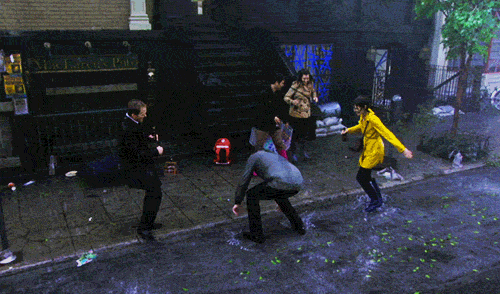
2. What We Do In The Shadows: This show is fucking hilarious. Just a bunch of pure of heart, dumb of ass bisexual vampires making a documentary about their lives. Nadja, my favorite character, is autistic and so is one of my best friends. To see her face light up at that kind of representation: unparalleled. There are only 20 episodes and I’ve seen each one four times. It’s hilarious. Colin Robinson the Energy Vampire is one of the most hilarious characters in television history.
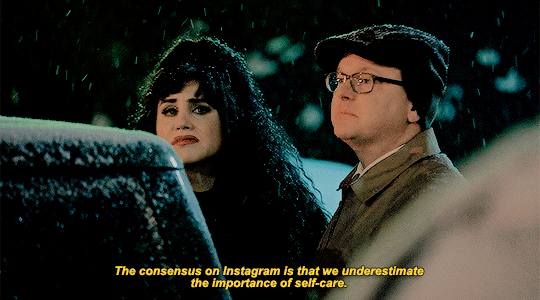
3. King of the Hill: My uncle introduced me to a lot of the shows from the 90s that I love. He used to babysit me and show my inappropriate stuff and this was one that always stuck with me. While being genuinely funny I think it does a fantastic job of showing that conservatives can also be kind and understanding people. Hank Hill is one of the greatest cartoon dads; he loves his son, he loves his wife, and any time he is wrong he takes the criticism graciously. Fantastically funny. Also includes the late great Britani Murphy.
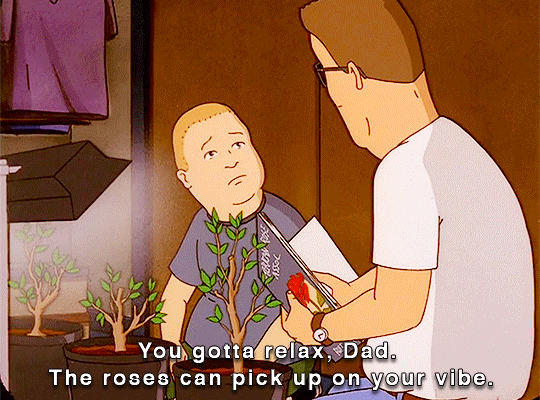
4. Daria: she’s one of the characters that I relate to the most. Misunderstood in her time, a fantastic portrayal of what it feels like to be the smart girl--the outsider. She eventually grows to understand that people care about her and what she has to say, that maybe her classmates and family members aren’t terrible. Incredible growth exhibited in someone so young. ALSO: the animation is so badass. Dry humor is the best humor.
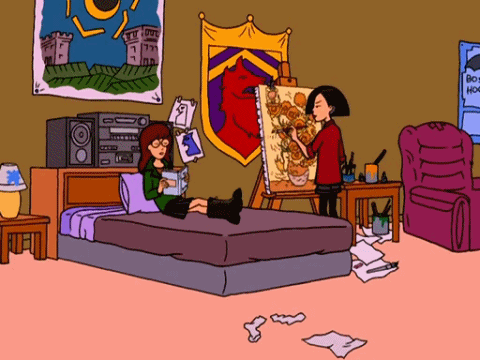
5. Pen15: Shows us that we all were so awkward in our youth and that, in many ways, we never really left middle school. At its core it’s a story about friendship--how important it is not to take yourself so seriously. Has a staggering amount of heart, as well. Love.
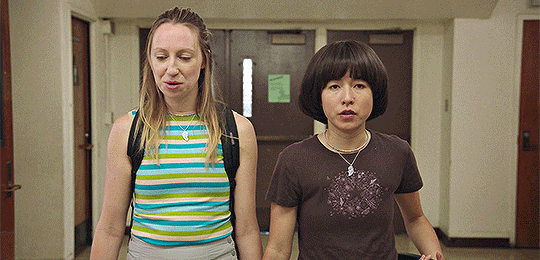
6. Bobs Burgers: Loving the people around you BECAUSE of their eccentricities, not in spite of them. Loving fully and completely until it consumes you. Loving without fear. Fantastic, i’ve been watching since 2011 and I’m so proud of how far this show has come.
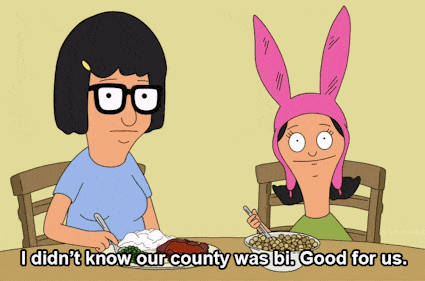
7. Sex and the City: First off, I’m a Miranda. While some of the concepts of this one are a little outdated, the heart of the show remains the same: friendship, good shoes, and good sex are the most important things in life. Carrie Bradshaw and her friends taught me that it’s okay to be unapologetically smart. And Sexy. And sweet. That being a woman isn’t one-toned, it’s multivocal. That there’s not wrong way to be feminine. Love. Not to mention every person in America knew if they were a Carrie, Samantha, Charolette, or Miranda (let me know which one is you).
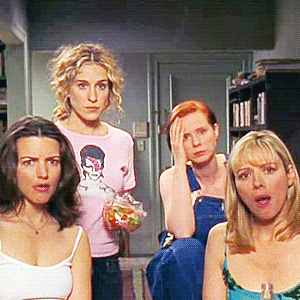
8. Grace and Frankie: You really don’t want to get me started with this one. Two women in their 70s must start fresh in life when their husbands leave them to marry each other. This show says so much about womanhood, how we are thrown away once we reach a certain age. It teaches us that it’s never too late to start over and live your best life. Lily Tomlin and Jane Fonda? Powerhouses. Icons. Heroes to young women for decades. This show has so many fans of so many different ages and I could talk about this show for HOURS if you’d let me.
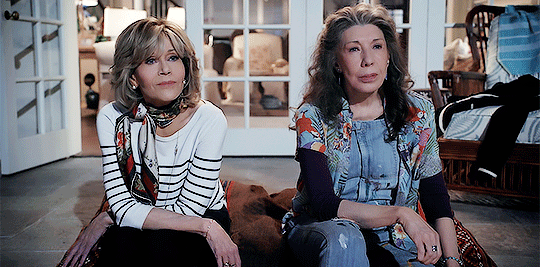
9. Gravity Falls: Spooky and funny and SO MUCH LORE! My gothy nerd heart sings every time I watch this. Such a beautiful message about growing up, too, which is one that always makes me cry. The buildup to the final moments of Weirdmegeddon 2 is incredible...I have a tattoo of Bill Cipher. And I’m a simp for outstanding animation. I could watch this show a trillion times and never grow tired of it.
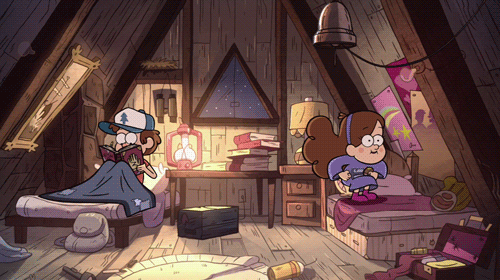
10. The Proud Family: I’m black, so. And I was in elementary school around the time this originally aired so it taught me a lot of really important things about race and personality and sticking together as a family. Also: Beyonce and Solange did the theme song. What else could you ASK FOR!
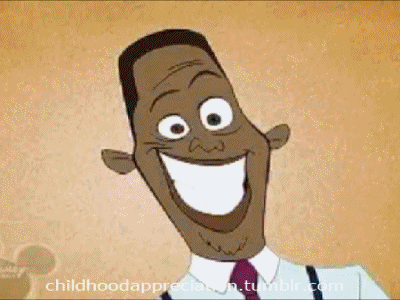
Honorable mentions: Blackish, Moesha, Sister Sister, A Different World, 30 Rock, Arrested Development, and New Girl.
I nominate: Anyone who feels so inclined! (I also don’t have 10 mutuals that I interact with regularly oops)
#grace and frankie#the proud family#daria#pen15 show#moesha#sister sister#gravity falls#sex and the city#bobs burgers#what we do in the shadows#king of the hill#how i met your mother
130 notes
·
View notes
Text
Sometimes I lurk in "old" tumblr fandom pages for things and have thoughts which may or may not be good, especially when they are one of the more YIKES (tm) ones even back in the day.
But, I overthink and my brain shifted to Teen Wolf. Now mind, I myself never got into that fandom as it was as I said YIKES (tm) for so many reasons. And I never really got into it as a series based on what I thought was amusing sometimes as background noise with some bad writing or acting. I just watched episodes as they came on and off when it came out as I just graduated high school I have never been committed to anything in it from an analysis stand point. And honestly this is a one time piece from my usual fandom niches lol, don't expect anything else from me regarding Teen Wolf ever again.
But I suppose with all of this hesitancy my biggest issue may have been with the fan base itself. For posterity sake, I'm mexican/chicana and raised in that typical sort of household community and such and a lot of this is really just my own messy thoughts surrounding the entire sub-culture of Teen Wolf through that lens.
My major focus for this is oh boy, Scott McCall.
Mostly for the good, I dunno 10 years now as a lurker for this series, I had noticed the habit of a lot of white-anglo (European for specifics) fans saying that they themselves don't see how he is Latino or even Mexican as a characterization. Which fair yes, Tyler Posey being Latino himself was shoddily incorporated by a white writer and not exactly explored as it is in fact a very american Hollywood tool when it comes to Latino actors and characters. But the really just tone-deaf use of this is the expectation of mexican-americans specifically seem to need to "be" a certain way to white fans. This issue is already largely ingrained within the latino community as a whole and this is glossed over in hollywood media itself as it either puts us in the pile of "just being american" and assimilated or some other outdated stereotype of "all Latinos are the same anyways".
A lot of the rhetoric against him is that he might as well be white, nothing is explored in his heritage. Which is a fault of the writing itself even when it leaned into heavy Mexican concepts for one of it's arcs. (That is also a whole other level of misappropriation by hollywood and it's absolute separation of anything mexican within it's own country).
Usually chicano/a characters are not allowed to have the exploration of what being Mexican is in America. It is encouraged very heavily in society for the past 80 years or so as media became for prominent. Scott from 2011 to 2017 was not allowed to be anything other than his american side due to the writers and it's prominently white base. He was singled out as another white boy through the writing as that is what hollywood does to latinos. In their eyes Mexican is American only so much as it can can be used as a minority point for clout.
It is a shame that Scott McCall through Tyler Posey was not able to recreate what it means to be Mexican American. Even as an actor for things, that get Tyler Posey socially grilled and called out for has an edge of growing up in the southwest chicano society of california even with his own actions and wording. I see this analyzed by white-anglos without a lot of the heavy needed cultural context to some of these actions. Especially for men in latino culture, there is a lot of machismo that is used by them that comes off as off-putting as arrogant and cruel. It is not an excuse for him but very much a culturally ingrained specific issue that we are all unfortunately aware of.
It is also uncomfortable as a Mexican to see certain words even with Scott McCall the character to have certain terms slung around by white fans degrading him on basis of "meta" analysis for the past 10 years. A lot of the popular ones are that he is not good enough, disgusting, selfish, taking away the rights and not appreciating the actions of the two other white male leads, he uses them. He is talked of as lesser, while innocuous through the usual white meta lens as not being harmful, is harmful when mexican americans are subjected to those words through a fictional character. Cultural ignorance seeps through and is brushed off as only being said as hate of the character who for all intents and purposes is one of the few prevalent main brown youth leads given to latinos, shoddiness be damned.
We do not have the privilege of having more to look forward to when a character that was made to be white is given to us. The ironic thing is that if he stayed white his actions would be praised given that Scott McCall's friend Stiles (the white secondary) is made to be "better" than the brown boy in plenty of fanworks. Scott becomes dehumanized and derided in these works to a frightening degree. He is unpopular to the white audience and only so much of the excuse of anti-character meta can be used when the social ramifications and ignorance seeps through to those of latino background.
#tentatively tagging as#teen wolf#scott mccall#don't mind me#there is just a lot of cultural dissonance with this character that is scary for me#I don't even really go here
18 notes
·
View notes
Text
2011 - I was so excited for W&K’s fairytale wedding. I was at university and was given a paper doll book of Kate with various wedding outfits for my birthday, which I stuck up on my wall. I felt optimistic a woman from a family that clearly understands hard work (as any small business owner surely does), who had spent time contemplating what her new role would entail before getting engaged but who also wore topshop and went clubbing, would be active and involved in promoting charities and make the family accessible to a new generation - overall an asset to the monarchy. I couldn’t imagine the UK without the pomp and circumstance associated with the royals, without the Queen, the nation’s grandmother looking after us all.
Ultimately however, I came to realise that there is just not sufficient transparency into the finances and the workings of the monarchy. The idea that members of the family are living in palaces and sold as ‘hard-working’ for attending a few hours of engagements and debatable levels of behind-the-scenes research in a climate where people work in demanding roles for minimum wage, worrying about keeping roofs over their heads and food on the table, is unsustainable. While the lack of privacy and relentless press obsession that comes with being a member of this family is obviously difficult to deal with, how does that compare to the constant worry about making ends meet and having enough money in the bank to pay your bills? What makes this family more deserving than the rest of us? In a modern democracy, it is unacceptable to cling to an outdated feudal system where our ‘betters’ rule over us by virtue of an accident of birth, rather than placed there by merit.
The main motivation of the Windsors is not to protect the UK and ‘their’ people - it is and always will be the continuation of the monarchy. Those two concepts can be mutually exclusive.
Once the Queen dies, I think the UK obsession with the royal family will experience a seismic shift and the questions of relevance and value will start coming thick and fast. Public affection for the Queen mostly protects the monarchy at the moment but I don’t see the same unmitigated fondness replicated for the later generations.
15 notes
·
View notes
Text
[ actually scratch that im going to rant about this bc ive read this book so many times and i have so many thoughts on it and nowhere to put them now that i don't primarily study history for a living and i accidentally wrote what is basically an informal essay about this. ]
my main gripe with guns germs and steel is that the author is an old white xtian man of the more classical anthropological stream of thinking and used outdated and inappropriate language when making his antiracist points, ex. "blacks" instead of "black people" which is difficult to swallow especially because he's doing that while trying to dismantle white supremacist ideology (like pick one, are you actively anti-racist or not? this came out in 2011 man you should know better. you can't talk about the horrors of the trans atlantic slave trade whilst simultaneously calling them that), and despite dismantling one major aspect of white supremacist pseudoscience he doesn't dismantle the entire 'root' so to speak. he refutes a major branch of it but not the inherent issues with this type of thinking, doesn't even acknowledge it fully, and that lessens the impact of his argument.
this book isn't a complete refutation of white racial pseudo-science, he doesn't really take apart other fundamental parts of that entire structure, he focuses solely on how geography impacts human societies and their development (which i don't necessarily fault him for, as geography is his primary expertise), but part of that idea needs inherently dismantling just at its base because the concept of "development" is highly racialized and contentious. he doesn't really acknowledge this, and seems to support this idea and even talks a bit about being friends with some mormon missionaries with whom he went to papua new guinea in the 60s and doesn't condemn that nor acknowledge how fucked up and weird that is, indicating that while he claims to be anti-racist there is a lot more work left that he has to do.
he subscribes to the idea that there are societies that are 'primitive' and those that are 'more advanced' - the theory of technological advancement as something both inevitable and inherent and a progressive climb upward, something traditionally taught to students of social sciences but is taught far less these days because it isn't correct and it's highly eurocentric. it isn't a matter of who is more 'advanced' or who has 'progressed' further (what is progression? what is advancement? who decides what this means? which societies are heralded as advanced, and assign a positive value to that, and primitive, and assign a negative value to that?) but rather that different societies have different values.
there is nothing evolutionarily 'lesser' about hunter gatherer or iron age or stone age societies. they don't represent a natural progression of human technological capacity, they represent changing values and needs. all societies value and conceptualize technology differently, and there is no positive or negative value to these concepts. ex. hunter gatherer nomadic peoples of the amazon are not "primitive" and "less advanced" they simply have different values than we do. the author suggests that anyone who CAN "progress" WILL choose to do so, and there would have to be reasons "preventing" them from doing so, despite acknowledging that different cultures have different values and have "gained" new tech and understood their intended use and CHOSE to simply discard it because it has no value for them within their society (ex. several indigenous peoples of papua new guinea) and never directly makes a statement on this ideology, just kind of eventually implies "i dunno the answer to this one i just know that they aren't inherently inferior to me" but there is a big difference between "INHERENTLY INFERIOR" and "INFERIOR" because you can believe that someone isn't Inherently lesser than you, from birth, tabula rasa "blank slate" style, but still believe that they are lesser than you as a result of things that they have chosen after that - as a result of their culture, and unfortunately while jared diamond declares that nonwhite people are not inherently inferior to white people, he does strongly indicate that he believes many of us are culturally inferior. he tries to make this into a valueless judgement, that there is nothing wrong with being "primitive" or "less advanced" it is just a fact, but there is no such thing as a valueless judgement when it comes to western anthropological thought, it is constructed from the base up to be about hierarchies and white supremacy.
there is no way to talk about "progress" "development" "civilization" without it being racially loaded, and he doesn't acknowledge this at all, which lessens the degree of his thesis' impact. you have to at least address these things in a book like this, you can't Not address these things, and you also need people of colour to go over your book pre-publishing so your elderly white ass doesn't release a book trying to refute racism while you simultaneously refer to people of colour with inappropriate language.
#long post#he is also a capitalist/pro-capitalism which also lessens his argument but thats another essay#i still recommend it despite its faults because there is a wealth of good info there and he accomplishes his main goal#but there are...so many issues with his beliefs underlying that and that are strongly implied#as someone who has spent a few years studying history and the social sciences and how racialization works#i can read between the lines and understand implications lol like its very clear to me that he holds these beliefs
33 notes
·
View notes
Note
Do you have any existing examples of world building a future that's actually accurate and predictive of the future? Say, ones that have depicted the last 5 years with some accuracy but created over 15 years ago. Or perhaps some future ones that aren't extreme sci fi writing genetically modified humans with superpowers or time travel in the next 50 years.
Tex: The Simpsons sure did give things a go (Metro, Business Insider).
That said, I could throw out some arguments in the line of “100% predictions are plausibly from time-travellers and would skew the time-line, likely creating catastrophic effects on spacetime as we know it” or something, but that would very quickly derail your question.
More realistically, Star Trek did a damn good job on the technological front (The Portalist, Quartz), and their cultural impact has been so significant that there’s a wiki on it. In this instance, I would argue rather more that the genre of sci-fi in particular has inspired our current technological advances - when we have an idea posited to us, it no longer becomes “impossible”, merely “improbable”.
Humans have historically liked a good challenge (or on the flip-side, really dislike being told no), so I would say that eventually most sci-fi things are created by sheer stubbornness. A warp drive, for example, has been talked about since at least the 1960s, but we’re slowly getting there in terms of real-world development (ScienceAlert, Universe Today).
We might not have the superpowers thing down yet (though that might take some paradigm changes, re: quantum entanglement in the brain and related topics - let’s scale our expectations of a “superpower” gradually), but we do already have genetically modified humans. Germ-line therapies (also known as somatic gene therapy, ScienceDirect) have existed for a while, and have many ethical issues arising from it (SingularityHub, National Academy of Sciences).
I do my best to keep up with as many STEM fields as I can, but in the past decade we’ve had a boom in development - I think if you asked someone in 2000 what sort of scientific and technological developments would exist by 2020, a good half of them might be wrong due to the simple fact that many fields just didn’t exist.
Given how long it took us to posit the theory of cellphones (in 1917 by Finnish inventor Eric Tigerstedt), to how long the first commercially available mobile phone was sold (by Motorola in 1973) - never mind flip phones (first posited in 1964 by Star Trek: The Original Series, first seen in real life via the Motorola StarTAC in 1996) - I would challenge anyone to bring a concept from drawing board to production line within ten years and have it be a commercial success!
There’s approximately 46 listed fields of engineering in this wiki, the Bureau of Labor Statistics cites that seven out of ten of the largest STEM fields were computer related in 2017 - the first concept of the modern computer was by Alan Turing in 1937 (Wikipedia), the first realization of this concept was with the Ferranti Mark 1 in 1951 (Wikipedia), and the first mobile computer was the IBM 5100 in 1975 (Wikipedia) - between Alan Turing in 1937 and the job statistics of 2017, a full 80 years had passed. I won’t delve more into the details of things like the history of social media, the Dot-com bubble, or literally anything about the 2000s, but suffice to say:
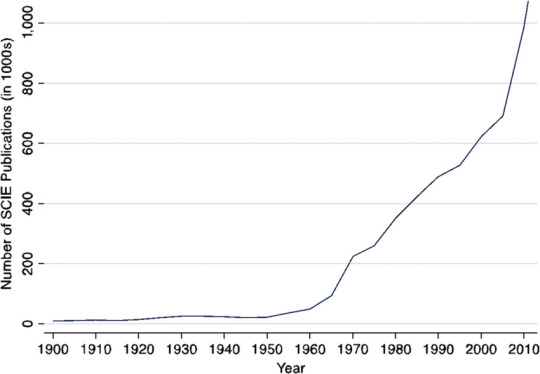
Description: Exponential Growth in STEM? Articles Published Worldwide, 1900?2011. Source: SPHERE project database of SCIE publications (Thomson Reuters' Web of Science).
STEM is likely increasing at an exponential pace (ResearchGate). I don’t know whether this means we’ll see things like the Enterprise, a TARDIS, or even Spiderman within our lifetime, but I distinctly would not preclude their possibilities just because our literature and scientific experiments didn’t have a palatable success rate. We got cell phones and 3D printing! I’m sure humans might be able to see things like superpowered humans or time-travel eventually, if not in our lifetime.
Delta: I’d also recommend The Martian by Andy Weir if you haven’t read it. It’s not super advanced sci-fi, so I’m not sure if it’s exactly what you’re looking for, but it’s an extremely realistic look at near-future space travel and Mars missions (realistic in every way, that is, except for the privatization of the American space industry; Weir wrote publicly funded space travel, which is looking less and less likely to be the case).
Station Eleven, by Emily St. John Mandel, is less sci-fi and more apocalypse/dystopia fiction, but takes a realistic, hard look at how humanity would actually react to an apocalypse, and is disturbingly familiar in 2020 (the main plot is a pandemic, so read with caution). Similarly, Octavia Butler wrote a great deal of similar future dystopia fiction; I’m particularly thinking of Parable of the Sower (warnings for rape, violence, riots, looting, etc.).
Mary Doria Russel’s The Sparrow is another good one. The timeline is a bit outdated, things didn’t happen as quickly as she thought, but her ideas about everything from space travel in asteroids to continuing violence in the middle east are more or less shaping up the way she predicted. She also takes a realistic look at what “first contact” would actually be like, as well as the actual ramifications of relative time caused by space travel. (While Russel is herself Jewish, Roman Catholic Christianity plays a very important role both thematically and in the plot, so this won’t be everyone’s cup of proverbial tea).
(On a related note, the movie Arrival by director Dennis Villeneuve is another sci-fi story that’s a very realistic (if somewhat trippy) look at “first contact,” but is set in the present day, rather than the future, so it’s not necessarily what you’re looking for, but I think very highly of it because of its realism and creative restraint, so it felt worth a mention.)
21 notes
·
View notes
Text
10 Years Later: “Work of Art: The Next Great Artist”
The reality TV show that forecasted today’s contemporary art and television landscapes
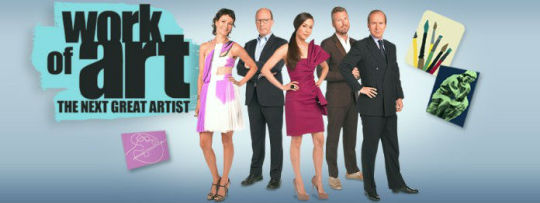
While the Bravo series only lasted two seasons before its 2011 cancellation, Work of Art: The Next Great Artist is a cultural treasure trove. The show was years ahead of its time—Despite premiering after (and being outshadowed by) big-name reality TV shows like Project Runway and America’s Next Top Model, Work of Art perfectly encapsulated and satirized reality TV and the fine art world while effectually becoming a work of art in itself: A concept so high it wasn’t even recognized or appreciated in its day.
Each season, fourteen contemporary artists competed through bizarre high-stakes challenges for the chance to win a solo exhibition at the Brooklyn Museum and a cash prize of $100,000. The series, which was produced by Sarah Jessica Parker, was backed by a cast of celebrity judges: actress and model China Chow, mega-famous art critic Jerry Saltz, and gallery owner Bill Powers; joined by Simon de Pury, famed Sotheby’s auctioneer who served as the quirky workroom mentor.
It’s obvious the show was much more “Next Great Artist” than “Work of Art.” As in, the art wasn’t great, but the contestants were. While a few provocative pieces were exhibited, most of the work was just “eh,” obviously made to fit a prompt. But with glorious irony, the artists themselves emerged as far more captivating than any of the work they produced.
When the average person lashes out on reality TV, they’re often written off as an actor or attention-seeker. “There’s no way a person would really react this way!” we accuse. But when it’s artists who act larger than life, the bit becomes believable. Countless misconceptions define our image of what an artist is like: A genius, a recluse, a nonconformist. Modeled after personalities like Van Gogh, Kanye, and Poe, artists are stereotyped as quirky, tormented outliers, prone to extreme behaviors and bouts of unrestrainable creativity. We find it believable when artists act eccentrically: It’s part of their creative process.

Work of Art: The Next Great Artist is a striking parody of what we believe artists are. In Work of Art, the most absurd contestants emerge as fan-favorites: A pop artist who calls himself “The Sucklord”; a weirdo performance artist everyone suspects is full of shit; a traditional realist painter who can’t fathom conceptual art; a self-trained artist with a distain for The Academy™️; and (my favorite) an interdisciplinary virtuoso adamant the best ideas came in his sleep, prompting him to stage frequent naps during challenges while others worked around him.
Work of Art was not designed to reveal the most talented artist, rather, the most interesting characters. The show’s Renaissance man model is outdated; no artist today has to excel in every type of challenge—found-object sculpture, commercial commissions, book cover illustrations, self-portraits and more. Contestants have to race to grab the best materials, struggle through team challenges, and defend their work in front of judges—Environments designed to elevate stress and reveal contestants’ most extreme reactions to pressure.
Instead of capturing the actual lives and processes of up-and-coming artists, the show captured another aspect of an art world that’s looking more and more like reality TV every day: The high-drama celebrity antics. Today, the art world is all about celebrity and scandal: Who can get into the news for the most bizarre, showy stunt, and who can be the next to outshine him? Rinse and repeat. Most recently, it was Banksy’s painting shredding at auction, then Maurizio Cattelan’s banana at Art Basel, then the hungry banana-munching performance artist who followed him. Each story blew up larger than the last, extending its reach from just art world insiders to household name dinner table fodder, consequentially skyrocketing the artists’ reputations.
Status is now equated with shock value in the art world on a major scale. The same can be said of reality TV—The genre’s hall of fame is made up of its loudest characters, with big personalities viewers love to latch onto and tear apart. Knowing this, contestants now go on shows with the sole intention of seeking attention, building a platform, and launching a career as an influencer or public figure. But due to the flood of reality TV stars, truly standing out is a skilled craft requiring strategy, complex character building, undetectable acting skills, and business savvy. Succeeding in today’s crowded reality TV influencer market is a form of art.

I propose Work of Art: The Next Great Artist was actually a work of conceptual art all along, and that its cast and crew designed the show with a nuanced understanding of contemporary culture.
While it may come off as fluff, Work of Art is actually a striking, poignant text about the relationship between art, reality TV, and celebrity antics (Spoiler alert: They’re all one and the same). Each artist used television as a medium to promote the self as an idea, as a product for consumption—A practice now commonplace in the contemporary art world. They adopted extreme personalities in hopes to outshine eachother with absurd stunts. And in doing so, they created a work of art that was equally emotionally moving and amusing, as all great works of art should be. The show epitomized what reality TV does best and what the art world does best—all the way back in 2010 when nobody could surely predict the trajectory of either medium.
Reality TV is, and always has been, performance art. But the cast of Work of Art took this to the next level, pushing the bounds of character acting while parodying the very medium they were working in. Despite this, the show was never taken seriously (Surprise surprise, reality TV being written off as frivolous!). I don’t take this as a failing on the show’s design, rather, it’s the kind of meta artwork that’s best appreciated in retrospect.
Today, as outrageous artist-celebrities and reality TV personalities have both exploded out of control, Work of Art: The Next Great Artist is all the more hilarious—A lighthearted parody of what could be (and what did become).
4 notes
·
View notes
Text
My Sanskrit Story
I am an ardent student of Sanskrit.
Over the past few years, I’ve been learning Sanskrit in a slow, schizophrenic manner – a few weeks of frenetic study of grammar and literature with long months of lackadaisical, lukewarm engagement with the language, mostly through ‘study circles’ (we’ll come to this later) that I’m a part of. But I have kept at it constantly and never regretted it once.
My earliest exposure to Sanskrit was perhaps at the age of two. Born and raised in a typical Hindu middle-class family, I was taught simple shlokas and stotras. My father took me to Cubbon Park or Ulsoor Lake on Sunday mornings and on the way he would teach me verses from the Mukunda-mala (a poetical work composed by Kulashekhara azhvar, a ninth century king and poet-saint). My grandmother taught me the Krishna-ashtakam (usually during power-cuts) and my mother taught me verses from the Venkatesha-suprabhatam. At age three or four, I became a sort of ‘installation art’ at weddings where elders gathered around me, coaxing me to recite verses from the Mukunda-mala. (But of course, getting children to recite verses is not uncommon in our families. Many of you might have experienced this in your childhood.)
That was it, pretty much: Some stray verses committed to memory and the strong notion that Sanskrit was a great language. In spite of my rejection of orthodox theism, rituals, and outdated religious/superstitious practices during my rebellious adolescent years, strangely, I never lost respect for Sanskrit.
Most of my cousins studied Sanskrit in school but I didn’t have that good fortune. I wanted to learn the language but I didn’t know where to start; for years it remained a pipe dream.
By sheer chance, I got involved in co-writing a translation of the Bhagavad-Gita with Dr. Koti Sreekrishna in 2006. At that time, I didn’t know any Sanskrit. My role was to review and edit the English; after Dr. Sreekrishna produced a rough translation, I would work towards presenting the verses in the simplest way possible. By the time we published the book five years later, I had learnt a few words here and there, particularly when we discussed the meaning of difficult verses.
In early 2011, when the manuscript of our Gita translation was being sent to reviewers, someone suggested that I get the opinion of the renowned scholar, poet, and polymath Shatavadhani Dr. R Ganesh. Until then I hardly knew anything about him. When I phoned him, he spoke in an encouraging manner and I felt like I was speaking with a family elder rather than a celebrity-scholar. He graciously reviewed the manuscript and gave his feedback. I casually mentioned to him about my interest to learn Sanskrit and my helplessness at not knowing where to start. Not only did he give me general guidance but he also taught me some of the basics of Sanskrit grammar like noun forms, verb forms, sandhi, and samasa. More importantly, he taught me the real value of learning Sanskrit in today’s world.
The rest of this piece comprises what I’ve learnt from Dr. Ganesh about the study of Sanskrit coupled with my personal experiences. It might be of value to those interested in learning the language.
~
Why Study Sanskrit?
Given that learning Sanskrit—or any language for that matter—consumes considerable time and effort (and some money), it’s a good idea to think for a moment if it’s actually worth it. Now, the worthiness can be decided only by one’s intentions – Why do I want to study Sanskrit?
In my case, I love learning languages when the opportunity presents itself. The process of learning itself is a great deal of fun for linguaphiles like me. So if you are a language-lover, there’s no need to think any further. Go and learn Sanskrit!
There is a widespread notion that Sanskrit is a sacred language meant solely for rituals and that its literature is entirely ‘spiritual stuff.’ So if you’re someone who likes that sort of thing – tradition, philosophy, scriptures, and so forth – you might be thinking of learning the language. The good news is that you probably don’t need to learn Sanskrit.
If you are just interested in the Vedas and want to connect with the tradition better, you could consider learning Vedic recitation, which is definitely easier than learning Sanskrit. In addition, you can read a book or two on the philosophy of the Vedas or listen to lectures on the topic by scholars like Dr. Ganesh. Even those of you who are interested in philosophy can get by reading reliable translations of the Upanishads and Bhagavad-gita as well as general works on Indian philosophy by scholars like Prof. M Hiriyanna.
There is a feeling among the culturally inclined nationalists that it is our duty to preserve Indian heritage and showcase the glory of India’s past. Triggered by this missionary zeal, some people might wish to learn Sanskrit. This often leads to a narrow interest in hunting for science in ancient India, or in the study of traditional works of polity, economics, architecture, law, or other secular subjects. Again, the good news is that you don’t have to learn Sanskrit to accomplish this.
You can always look into reliable translations of works like Artha-shastra, Manu-smriti, Surya-siddhanta, or Brihat-samhita. You can also peruse through books on Indian history, ancient Indian mathematics, temple architecture, and so on. You could even take up the study of a serious treatise like P V Kane’s History of Dharmashastra. That will satiate your thirst to a large extent.
When something can be effectively translated from one language into another—particularly when the objective is to provide information or teach certain concepts—then there’s hardly a case for learning the source language. If I can give you the exact translation of a verse from the Gita and you understand it without any transmission losses, then why do you have to spend ten years of your life learning Sanskrit?
But there are things that simply can’t be translated. Jokes, for instance, are untranslatable when they employ puns or have strong cultural references. The same goes for poetry, where the structure and the substance are closely intertwined. So if you’re interested to explore the vast landscape of Sanskrit literature—Kalidasa’s masterpieces; the two great Epics (Ramayana and Mahabharata); Bana’s Kadambari; Shudraka’s Mricchakatika; Bharavi’s Kiratarjuniya; Vishakadatta’s Mudra-rakshasa; and many other poems, plays, and prose compositions—it is worthwhile taking steps to learn Sanskrit. Stories about gods and goddesses, romantic escapades, nature descriptions, episodes from the Epics, idiosyncrasies of public life, the history of a kingdom, tales of commoners – all this and more can entertain and enrich several lifetimes.
In addition to being a wonderful treasure trove of literature, Sanskrit is also a window to our past. Therefore, any serious student of Indian history, archaeology, sociology, culture, sculpture, philosophy, and so forth will benefit immensely if s/he learns Sanskrit. Here I wish to make a distinction between one who is interested in Indian history or philosophy or culture and a full-time student of these subjects (like a BA or MA student). Those who are merely interested to know more about a certain era in Indian history can read a book by R C Majumdar or Jadunath Sarkar and be fulfilled. But for students of history, the knowledge of Sanskrit will enable them to read inscriptions, contemporary literary works, and so on, which will prove invaluable for their careers.
However, if you’re looking to improve your knowledge of physics, become better at technology, get a promotion at work, or win an election, you will benefit from doing other things than learning Sanskrit.
Is Sanskrit Difficult?
A good way to learn a language is like how we all learnt our mother tongues – by listening and repeating, then slowly moving towards understanding and speaking, and then eventually starting to read and write. If you wish to learn Russian, Spanish, or Japanese, this approach works well. But Sanskrit is not a widely spoken language. And our motivation to learn Sanskrit is not so much trying to communicate with other people as it is to read and savour ancient (and modern) literature.
Although there are a number of people who fluently speak in Sanskrit, it is almost impossible to find a person who knows only Sanskrit and no other language. It’s therefore obvious that you don’t need Sanskrit to communicate with others; you can get by speaking Kannada or Tamil or English. (On the other hand, if you’re visiting the UK and can’t speak a word of English, you’re going to be in trouble!)
To learn Sanskrit, you might have to choose an approach that’s different from what’s popularly known as ‘immersion’ in language-learning circles.
There are some people who think that Sanskrit is extremely difficult and wonder if they can approach it at all. In fact, those who are familiar with one or more Indian languages already have the basic equipment to understand Sanskrit. The nuts and bolts of the grammar can give you sleepless nights but it’s probably not as hard as you think.
At the other end of the spectrum, there are people who think that attending a ten-day Sambhashana course or reading a ‘Learn Sanskrit in 30 Days’ book can give you mastery over Sanskrit. That’s a dangerous notion to harbour if you really want to learn the language.
So, the one line answer is that if you’re interested and pursue it sincerely, it’ll get easier along the way, and more importantly, the journey will be great fun after the initial fumbling about.
Learning Sanskrit
Where do I start?
The answer, surprisingly, is: anywhere. Just start. Sanskrit is an ocean and where does one begin to swim in an ocean? Somewhere. Put your feet in the water, slowly get inside, get used to the cold, and before you realize it, you’re already kicking your legs and having a good time.
And that’s what I did: just started at some point.
I would read a verse from the Gita and then read the English translation. I had learnt Kannada and Hindi at school and as a result, many of the words were familiar to me. Reading the translation after reading the original Sanskrit verse exposed me to new words. I committed verses to memory and later replayed them in my mind, trying to check if I remembered the meaning completely.
That said, the most suitable works to start off learning Sanskrit are lucid compositions like the Ramayana or the Pancha-tantra. Get hold of a reliable translation of one of these works (preferably in an Indian language); start by reciting the original Sanskrit verse or prose passage a couple times, then read through the translation, and go back to reading the Sanskrit – this way you slowly make connections between the words and their meanings. Instead of diving into the technicalities of grammar straightaway, spending time with literature will help you experience the beauty of the language.
Three to six months after commencing the study of a Sanskrit work, you can start learning up some grammar – by reading good books, watching online tutorials, or learning from a teacher.
I’m extremely fortunate that Dr. Ganesh taught me the basics of Sanskrit grammar. That set me off on a winding path of reading different aspects of grammar and trying to wrap my head around them. This continues even today. The more I hunt for rules, more the exceptions I find. My advice: Keep aside logic while learning basics. In the initial stages, don’t ask questions; simply accept things as they are. It just makes life easier. Over time, you’ll develop an intuition for the correct form of a word.
All said and done, it’s easy to start but difficult to keep going. What’s the solution for sustained study?
In my experience, learning a language requires both self-motivation and external agency. Unless one is driven from within, no amount of external push will be fruitful; when self-motivation is present, external agency becomes invaluable. For instance, Sanskrit is taught in schools and colleges – this is a push from outside (i.e., external agency). But only those with self-motivation learn the language well and continue reading literature long after they have graduated.
When I met Dr. Ganesh in 2011, he told me about a fortnightly ‘study circle’ he was conducting and extended an invitation to me. I had never heard the term before so I asked him what that was. A group of friends would catch up every other Saturday and read the Raghu-vamsham of Kalidasa.
I started attending the study circle. This went on for close to a year and I learnt a great deal. Owing to various reasons I became irregular in attending the sessions and after I shifted to another end of the city, I practically stopped going. During the years 2013–16, I moved around quite a bit and finally I shifted to Malleswaram in November 2016.
There came an inflection point in my Sanskrit study in 2017. Around that time, my good friend Raghavendra G S had started his PhD program in IISc. and my house happened to be a sort of midpoint between the metro station and his lab. One day I casually suggested that we should meet once a week and read a Sanskrit work together. He readily agreed and we started reading the Krishna-karna-amritam (a poetical work by Lilashuka). By the time we finished reading the text in early 2018, a few other friends showed interest in coming together to form a study circle. And so, in April 2018 we formed our Sanskrit study circle and have continued ever since. I also got the opportunity to join a few other study circles and this ensured that my Sanskrit study is ever fresh; over the past three years, not a week has gone by without a few hours of Sanskrit reading (unless I was travelling or unwell).
So if you want to learn Sanskrit, try to find even one other like-minded friend and get started. Even better if you can find more friends – especially those who know more Sanskrit than you. The ideal is a group of four to six, meeting once a week, for about an hour or ninety minutes. (You can meet in person or online – it shouldn’t make too much of a difference.) There are ample online resources and translations available for various Sanskrit works. Start reading a work together. Take turns to read the verses aloud. (Even when you’re reading Sanskrit by yourself, it’s useful to read aloud). Then look at the translation. Discuss. Read the original verse again. Then move forward. In the first few sessions, you may read just three or four verses in an hour but as you go forward, your speed will drastically improve and you’ll start getting comfortable. After a while, refer to the translations only after you’ve made an attempt to understand the original. This will slowly push you to rely on your memory and learning.
And once in a while, when there’s an opportunity to meet during a long weekend, you can take a short poetical work like Niti-shataka or Kali-vidambana and read the whole thing in one marathon session.
There are many possibilities with study circles. In fact, it can prove to be the mysterious ingredient to accelerate your learning. That’s been the case with me for sure. I’ve still got a long way to go before I can say that I’ve learnt Sanskrit but the journey itself has been incredible so far. Dr. Ganesh and friends have been largely responsible for what little Sanskrit I know. And for that I’m ever grateful.
Hari Ravikumar August 2020
Thanks to my friends Pratap Simha (for getting me to write this piece), Arjun Bharadwaj (for his valuable inputs), and Sudheer Krishnaswami (for his review and feedback).
2 notes
·
View notes
Text
1st week Peer-Graded Assignment
For this first assignment, I was supposed to choose the data set and create a research question.
I decided to use the Gapminder dataset.
In my country, specifically in the area where I am from, there is a general conception that people from the countryside, or less urbanized areas have a tendency to be binge drinkers.
I believe this is a misconception, so I decided to use the following dataset to answer the question: Does the rate of urbanization directly affect the consumption of alcohol by the population?
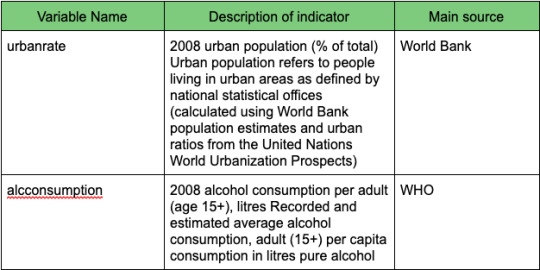
The Unique Identifier is the Country name
To start, I went looking for additional literature on the issue. I used the terms: Urbanization, drinking habits, alcohol consumption, substance consumption, substance abuse, alcoholism.
Most of the articles that I found were somewhat outdated and were focusing on specific populations, but generally what they found is that the consumption of alcohol is bigger in more urbanized areas.
In a 2010 study about the consumption of substances by Slovak adolescents, the authors, Pitel, Geckova and vanDijk state that there is a likelihood of adolescent health endangering behaviors in higher urbanized areas (1)
In another study, from 1996, Takano, Nakamura and Watanabe also found that the alcohol consumption between Japanese women increased in a direct connection with urbanization. (2)
A more comprehensive study was published in 2005 by WHO. The study is not only focused on drinking, but on the impact of substance use by young people in urban environments. They do identify several other risk variables to young people when it comes to substance abuse, but it is clear that urbanization is directly linked to increasing the consumption. (3)
After that research, I developed the hypothesis that countries with higher urban rate have a tendency to have higher alcohol consumption by the population. And that is what I will try to show by analyzing the data set.
REFERENCES
1. Pitel, L., Geckova, A.M., vanDijk, J.P. et al. Degree of urbanization and gender differences in substance use among Slovak adolescents. Int J Public Health 56, 645–651 (2011). https://doi.org/10.1007/s00038-010-0219-3
2. Takano, T., Nakamura, K., Watanabe, M. Increased Female Drinking in Accordance with post-industrial Urbanization in Japan. Int Alcohol & Alcoholism, Vol. 31, No. 1,41-49 (1996). https://academic.oup.com/alcalc/article/31/1/41/215955
3. World Health Organization. (2005). Substance use among young people in urban environments / edited by Isidore S. Obot & Shekhar Saxena. World Health Organization. https://apps.who.int/iris/handle/10665/43326
1 note
·
View note
Text
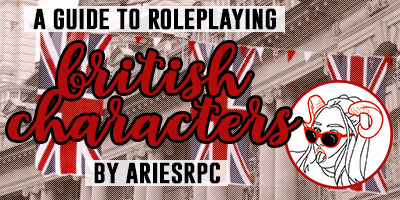
in honor of a recent rise in roleplays set in the uk, coinciding with the recent global success of the new british netflix show sex education, i was inspired to create this guide to roleplaying british characters. as a british kid myself i love seeing these characters in rps, but have often had friends in the rpc tell me that they struggle to write them due to the differences in popular culture, dialect, slang, media etc.
of course, accuracy isn’t TOO important when it comes to this, since british people generally aren’t a marginalized or oppressed group. however i do think this is a guide a lot of people will find valuable. in a poll with 43 respondents, the highest percentage of roleplayers were from north america (72.1%) compared to only 9.3% coming from the united kingdom (all info correct at time of posting). with the assumption that people mostly write characters that are from the country they’re most familiar with, there aren’t a lot of british characters in tumblr rp. if this guide can provide non-UK-based rpers with the info they’re seeking to pen a british muse, then my job here is done!
DISCLAIMER: if you were looking for a guide written like an essay or report, this ain’t it! this is mostly a collection of external resources you may find useful when writing your characters, as opposed to written instructions.
PLEASE, LIKE OR REBLOG THIS IF YOU FOUND IT USEFUL IN ANY WAY!
GEOGRAPHY — where will your character be from?
as a british person who isn’t exactly the most well-traveled, there are definitely inaccuracies in my knowledge of other countries’ geography. i wouldn’t be surprised if some people struggle with the same issue, but regarding the united kingdom. if your character is from the UK, it’s important to know that their characterization should differ depending on which part they’re from.
map of the british isles
map of england
map of scotland
map of wales
map of northern island
the difference between the UK, great britain, and england: explained
why is the republic of ireland not a part of the united kingdom?
NOTE: this guide will not include info on how to write characters from the republic of ireland, as that identity is one of its own and is not classified as part of the uk!
SOCIAL CLASS — what kind of socio-economic background will your character have?
class is an important issue in the UK, in some ways more-so than the US. the first bullet point of this section is an interesting article which explains why this is, but to summarize: the american dream – though flawed, is a reality to an extent. there is no such concept in the UK, making the class situation and socio-economic divide a little different.
“in the uk, i’m working class, but said goodbye to that title in america” article
the seven social classes of 21st century britain — where do you fit in?
POLITICS — what kind of stance will your character take?
just like in any country, politics is extremely important in the UK. just like in america, the country is extremely divided between left and right. if political views is something your character views as important, or you think that their politics defines their characterization in any way, this section should be helpful!
parliamentary (UK) vs. presidential (US) democracy, explained
the uk’s many political parties, explained ( NOTE: this video is slightly outdated. the prime minister, and leader of the conservative party, is now theresa may, not david cameron. but you probably already knew that. )
uk political spectrum
2017 uk general election map
brexit, explained
to summarize the two main parties: labour = left-wing = good. conservative = right-wing = bad.
ETHNIC DIVERSITY — what kind of ethnic background will your character have?
similarly to the US, the UK (though dominated by caucasian people aka white british) encompasses many different cultures. according to the UK gov “87% of people in the uk are white, and 13% belong to a black, asian, mixed or [from] other ethnic group[s], according to the combined 2011 censuses.” while non-white ethnicities are a definite minority, it’s so important not to erase their existence.
a chart illustrating the uk’s race / ethnicity breakdown
britain’s most racially diverse areas
2011 census reveals most ethnically diverse city
IDENTITY — what kind of cultural identity will your character have?
ask a scotsman for a handful of reasons he’s different from an englishman, and he’ll talk for hours. within england alone, ask a londoner how they’re different from a mancunian and they’ll talk for even longer. different parts of the uk have different identities, and it’s important. something we want to avoid is the “posh”, well-spoken, crumpet-eating stereotype or, on the other end of the spectrum, the modern-day oliver twist. expand your horizons!
stereotypes americans have about british people that aren’t actually true
10 differences between brits and americans
what does it mean to be british?
ENGLAND
how is the south of england different to the north? (spoiler: very)
north-south divide wikipedia
culture of england wikipedia
SCOTLAND
our scottish culture: so much more than kilts and bagpipes
scottish culture and traditions guide
culture of scotland wikipedia
WALES
wales history, language and culture
welsh culture: facts and traditions
culture of wales wikipedia
NORTHERN IRELAND
northern ireland – cultural life
northern ireland history and culture
culture of northern ireland wikipedia
LANGUAGE, DIALECT, ACCENT, SLANG — how will your character speak?
here’s where the fun parts start! there are so many different variations of accents, regional dialects, area-specific slang and colloquialisms throughout the uk. sometimes i see british characters being written with little to no use of any of these, nothing at all differentiating them from american characters and it’s such a waste in my opinion. even if you don’t like writing with a an accent (some people don’t!) the dialect and slang words along can make your character so much more authentic.
how are british english & american english different?
everyday american words we don’t use the same in the UK
america vs british english – 50 differences
NOTE: resources for the north of england are higher in quantity than the midlands and south of england due to wider variations of accents within the region.
ENGLAND (NORTH)
a tour of northern english accents
a - z of northern slang (GENERAL NORTHERN)
northern slang with blossoms (GENERAL NORTHERN)
a - z of mancunian slang (MANCHESTER)
mancunian: english like a native (MANCHESTER)
scouse: english like a native (LIVERPOOL)
scouse slang (LIVERPOOL)
geordie slang (NEWCASTLE)
mackem slang (SUNDERLAND)
yorkshire slang (YORKSHIRE)
the yorkshire accent (YORKSHIRE)
sheffield slang (SHEFFIELD)
arctic monkeys slang lessons (SHEFFIELD / YORKSHIRE / GEN. NORTHERN)
ENGLAND (MIDLANDS)
how to speak birmingham (BIRMINGHAM)
a brummie accent (BIRMINGHAM)
7 things said in nottingham (NOTTINGHAM)
black country dialect (BLACK COUNTRY)
ENGLAND (SOUTH)
10 common british/english slang expressions & phrases (NON-SPECIFIC)
cockney (LONDON)
cockney rhyming slang: english like a native (LONDON)
roadman slang vs cockney slang (LONDON)
london street slang, translated (LONDON)
west country: english like a native (WEST COUNTRY / SOUTH WEST)
essex slang (ESSEX)
mark watson on bristol slang (BRISTOL)
slang of the south - portsmouth (PORTSMOUTH)
WALES
welsh people on welsh slang (GENERAL WELSH)
taron egerton talks welsh slang (GENERAL WELSH)
common welsh sayings (GENERAL WELSH)
luke evans on welsh slang (GENERAL WELSH)
25 words and phrases you’ll always hear in cardiff (CARDIFF)
swansea slang (SWANSEA)
20 welsh colloquialisms (GENERAL WELSH)
29 words that have a totally different meaning in wales (GENERAL WELSH)
welsh language wikipedia
SCOTLAND
how to speak & understand glaswegian (GLASGOW)
gerard butler teachers you scottish slang (GENERAL SCOTTISH)
glasgow slang words (GLASGOW)
most used scottish slang words & phrases (GENERAL SCOTTISH)
doric from around aberdeen (ABERDEEN) note: definitions in description
edinburgh dialect words (EDINBURGH)
trainspotting slang explained (GLASGOW / GENERAL SCOTTISH)
scottish words glossary (GENERAL SCOTTISH)
glossary of scottish slang & jargon wikipedia (GENERAL SCOTTISH)
handy scottish words to know (EDINBURGH / GENERAL SCOTTISH)
28 great scottish sayings and slang phrases (GENERAL SCOTTISH)
use of gaelic in scotland wikipedia
NORTHERN IRELAND
jamie dornan teaches you northern irish slang – vanity fair (GENERAL N. IRISH)
jamie dornan does northern irish slang – bbc (GENERAL N. IRISH)
28 sayings from northern ireland (GENERAL N. IRISH)
northern irish words (GENERAL N. IRISH)
16 slang phrases you’ll need to know in northern ireland (GENERAL N. IRISH)
17 words and phrases you’ll always get in belfast (BELFAST)
a list of belfast sayings (BELFAST)
derry slang words 1 (DERRY)
derry slang words 2 (DERRY)
use of gaelic in northern ireland wikipedia
SURROUNDINGS — what’s it like where your character grew up, or where they live now?
whether your character comes from one of these places OR lives there now (or both!) it might be interesting to incorporate some of their surroundings into their characterization. this section isn’t classified by country/region, because if i were to start going into that much detail here, this guide would go on forever!
10 incredible historical towns in the uk
where are the largest cities in britain?
a guide to the english countryside
the 15 most stunning places in the uk outside of london
top 50 areas for quality of life in the uk
10 best party cities in the uk
10 best student cities in the uk
10 of the uk’s most creative towns & cities to live, work & play
cities with the youngest vs oldest age population
map of stereotypes in the uk
google autocomplete map of the uk “why is [city]...”
POP CULTURE / MEDIA — what does your character like? what are they consuming?
us brits are very proud of our own british-made media. our television, our music, our cinema, etc. if you’re somebody who is interested in including the things a character likes in their characterization, it would be unrealistic not to give a british character some favourites from the place they’re from.
uk map showing where tv shows are set and filmed
uk map showing the origins of famous bands/musicians
the uk’s most popular tv shows according to IMBD
10 best british rock bands of the 21st century
the ultimate reference guide to british pop culture
LASTLY, HERE ARE SOME RESOURCES ON WRITING BRITISH CHARACTERS:
making british characters realistic as an american writer
tips from a brit for writing british fictional characters
another ‘writing british characters’ guide by @thewritershelpers
another ‘writing british characters’ guide by @writeworld
another ‘writing british characters’ guide by @rphelper
how to write dialogue for british characters
writing black british characters by talkthepoc on wattpad
of course, this is overkill. there’s no way on earth you’ll ever need all of these resources, but they’re here and i hope you find some use out of this guide! please forgive any inaccuracies or mistakes, this is my first time writing a guide. you’re welcome to leave me feedback on this here. last but not least, HAPPY WRITING!
114 notes
·
View notes
Text
Injustice 2
They say fighting games are a very conservative genre. They say that it is not easy to start playing them, it is even more difficult to understand, and even to reach a decent level at all by units. They also say that mere mortals have almost nothing to do there: they say that they play a little, and more and more in Japan, where arcade machines are not a luxury, but simulators for Champions. Nonsense! Injustice 2 consistently and mercilessly debunks myths, demonstrating what a bruiser should be able to please everyone. Myth 1: you can't just play fighting games New series of fighting games appear very rarely, and even less often are fixed in the minds and hearts of players for a long time. Agree, it is much easier to deal with the continuation of the familiar cycle than to learn something from scratch. Street Fighter, Tekken or Mortal Kombat are known to everyone — but who will remember Dive Kick, Skullgirls or some Under Night In-Birth? This is why it is considered that the entry threshold is very high, and most players stumble on it.
Injustice 2
Studio NetherRealm, the creators of Injustice and the much more famous Mortal Kombat, are struggling with this installation. Each of their games is a step from a hardcore combat system to an affordable option for those who are too lazy to learn tooth-crushing combos. In the end, the average gamer does not sit down for fighting games in order to break their own fingers in blood.
In strict accordance with this philosophy, three buttons in Injustice 2 are responsible for weak, medium and strong blows, and the fourth allows you to activate a special ability. If you want, you can grab items scattered around the arenas and also use them — again, with just one button. Finally, when the energy bar is filled to the maximum, the hands themselves reach out to activate the superstrike to enjoy an impressive scene, after which the enemy will not be counted for at least 40% of life. Injustice 2 is not even divided into rounds — each fighter enters the fight with a double health bar and is only interrupted for a second when he loses the first half.
Injustice 2
Entertainment, simplicity, and dynamics are the cornerstones of Injustice 2. While others are only looking for their way to the masses, NetherRealm is already there, among the people.
Myth 2: Fighting games quickly exhaust themselves and turn into merciless simulators So, we figured out that you don't need any special skills to enjoy Injustice 2, except for the ability to hold the gamepad. We will also understand why this should be done.
Injustice 2
The first tangible blow to the standards of The netherrealm genre was dealt back in 2011: it was then that Mortal Kombat had a somewhat rough, but impressive story mode. If, for example, the authors of Call of Duty and StarCraft can balance the single-user and network component, then why have not yet thought of this in fighting games? For 6 years, the concept of a monolithic narrative with a regular change of actors has passed the test of three games. Injustice 2 also takes it to a new level, which is largely facilitated by the comic theme.
Injustice 2 is dedicated to DC Comics characters-Superman and Batman, which we dreamed of dressing up for children's matinees. Or Wonder woman, which will soon be admired in cinemas. And almost three dozen no less bright and colorful personalities.
The first part was about how A man of steel went crazy on the grounds of the death of his beloved, and then arranged a tyranny on a sinful Earth. Batman also led the resistance forces and eventually put the kryptonian in a special Solarium that simulates the light of the red sun. It would seem that this is the happy ending. But no. There were sympathizers. There are still personal accounts to settle. Unrealized hopes and aspirations. And to top it off, a galactic-scale villain, Brainiac, burst onto the blue planet — the former enemies will have to join forces to defeat him... Or not.
The Injustice 2 story mode is a dozen chapters of a single story, modest, but still non-linear, two endings and a lot of clips with facial animation of the Uncharted 4 and Quantum Break level, no less. Reproach him is only in brevity — the passage requires at least four hours. At best, five, to achieve the coveted one hundred percent.
Injustice 2
After the superhero conflict is exhausted, your hands will reach for the "Multiverse"mode. This is a kind of evolution of the "tower" from Mortal Kombat-sequential tests, often with different (mocking) modifiers. There are also hourly, daily and weekly tasks, the passage of which promises pumping and rewards. And this variety distinguishes Injustice 2 from a number of similar action games.
Myth 3: Balance in fighting games does not tolerate changes in characters The story mode, three dozen fighters, and a bunch of modes in Injustice 2 are supported by the equipment and leveling system. Successes in arenas are rewarded with experience, and some also with special boxes. In them, you can find, for example, a new helmet for the Flash or a corset for the Catwoman. There are countless items, they differ in level and rarity, give various bonuses and are collected in sets.
Injustice 2
Someone will probably object and say that there is customization in a great variety of games. But in Injustice 2, all the items put on somehow change not only the appearance, but also the characteristics of the ward. A little effort, and now your Aquaman is twice as strong as the standard version, and the Cheetah has started to move a little faster. In other words, customizing the appearance affects not only the appearance, but also brings real benefits. Up to the appearance of additional techniques.
Only one of the creators of Injustice 2 did not depart from the traditions. For fun online, you can measure levels and found items, but in a competitive game, a special setting disables any modifiers. This is logical: if you want to claim Olympic gold, you will have to give up Meldonium and steroids.
At the dawn of justice Remember, we started with the conservatism of fighting games and the potential of Injustice 2? The brainchild of Netherrealm has everything to popularize the genre and become a role model. Outdated Street Fighter V, retrograde Tekken 7 and significantly inferior in popularity Guilty Gear Xrd is unlikely to make it a worthy competition.
Only one thing can prevent the success of Injustice 2 — the insane popularity of Mortal Kombat. Four years ago, it easily eclipsed all the achievements of the first battle of Superman and Batman. Let's hope that the second attempt of NetherRealm to pit famous DC characters will not be wasted.
1 note
·
View note
Photo
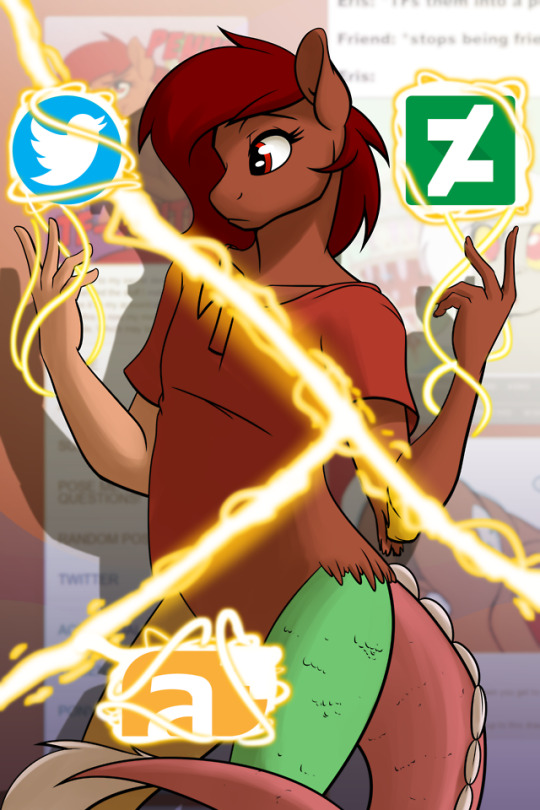
This is -NOT- the end.
With the upcoming NSFW ban, this blog of mine will unlikely survive the purge. I’ve already had several posts flagged (of course, considering the NSFW nature of my work). While I always disliked Tumblr for many reasons, the concept and ideas behind it were pretty sound- On no other platform could I so readily communicate with my:
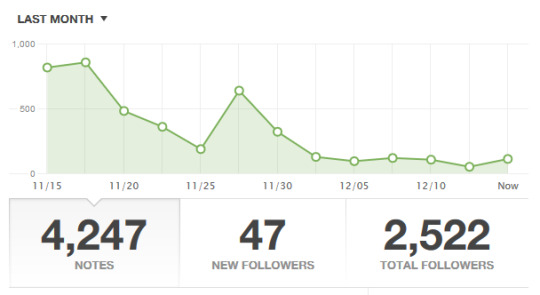
Hoo, wow... 2,522 followers. For someone who draws a lot of a niche (transformation) in a niche (ponies), I think that’s a pretty respectable number!
I want to first give a great thank you to all of you who have followed my work
I’ve been into TF since I was a kid, almost as long as I could remember. I’ve also been into ponies since 2011, and what a fantastic ride its been. When I decided to marry my interests together back in 2012/13, because I felt like there were not enough folks draw pony transformation art back then.
Never would I have imagined that I’d have as many fans of my work as I do now, nor did I expect to break into the TF art community at large through my work. I am now friends with many artists whose work I’ve followed since I was a kid, and that’s really amazing.
I’ve made over 1,651 posts, with this one being the 1,652nd and final post. A lot of that is art I’ve made, or art friends have made. All over the course of 4-5 years.
Through this tumblr platform, I’ve followed so many wonderful artists, people, and resources. There are some people who I really only have a decent contact through tumblr, and my heart aches that I may not be able to keep up with them as readily as before. But our hooves are tied, and its clear we aren’t wanted here, so we must make due with what we got.
Where to now?
If you want to keep up with my work, there’s a lot of places for you to go check out! I’ll list them all below. Most of them are really outdated due to me relying largely on tumblr, but that will change soon.
ACESENTIAL DEVIANTART
Expect my regular pony and non TF art here.
TF-SENTIAL DEVIANTART
Expect my TF art here, sans NSFW versions.
TF-SENTIAL FURAFFINITY
Expect all my TF work, NSFW and SFW, here.
ACESENTIAL/TF-SENTIAL DERPIBOORU
This catalogues most of my finished pony work.
ACESENTIAL TWITTER
Expect SFW non TF work here. I may set up a TF-sential twitter down the line.
So long and farewell Tumblr...
With that, I bid you all a farewell. Thank you for making the past few years a special one. As I’ve said before, the pony fandom is something very near, dear, and special to me. In it and through it, I’ve made so many friends, gotten so many opportunities, and solidified what I want to do with my life.
Thank you, all. I hope to see you around.
Sincerely,
Acesential
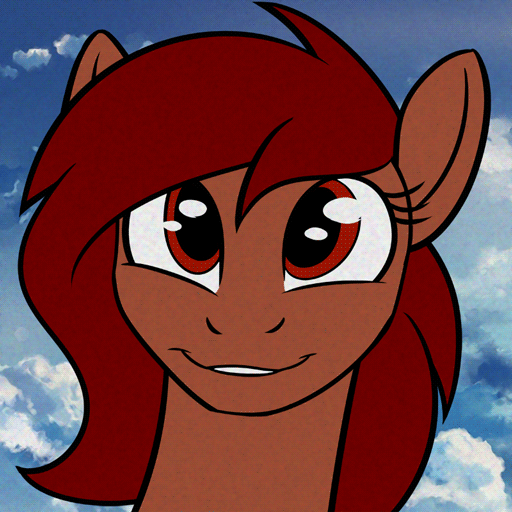
173 notes
·
View notes